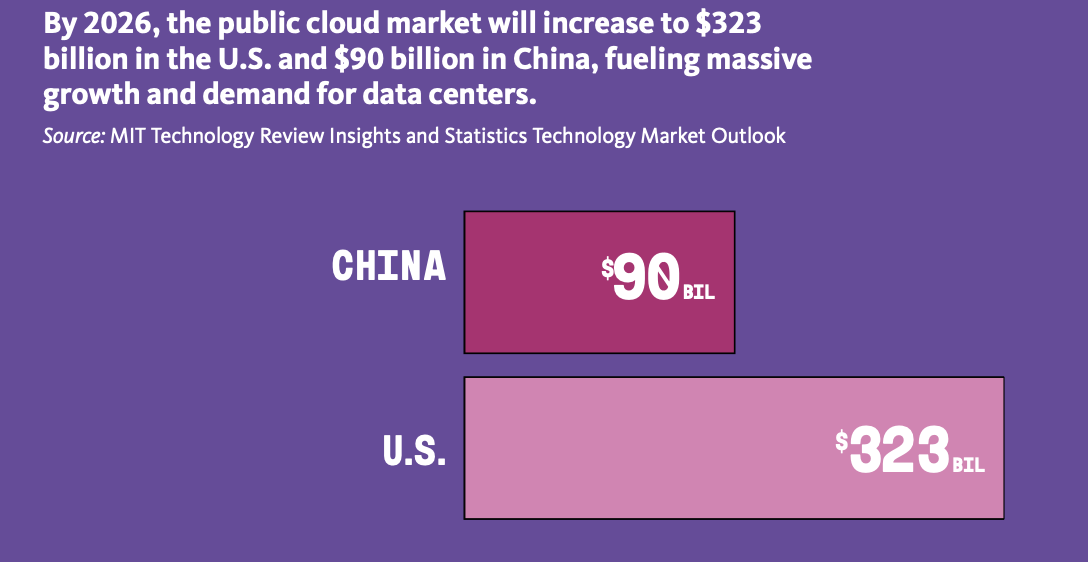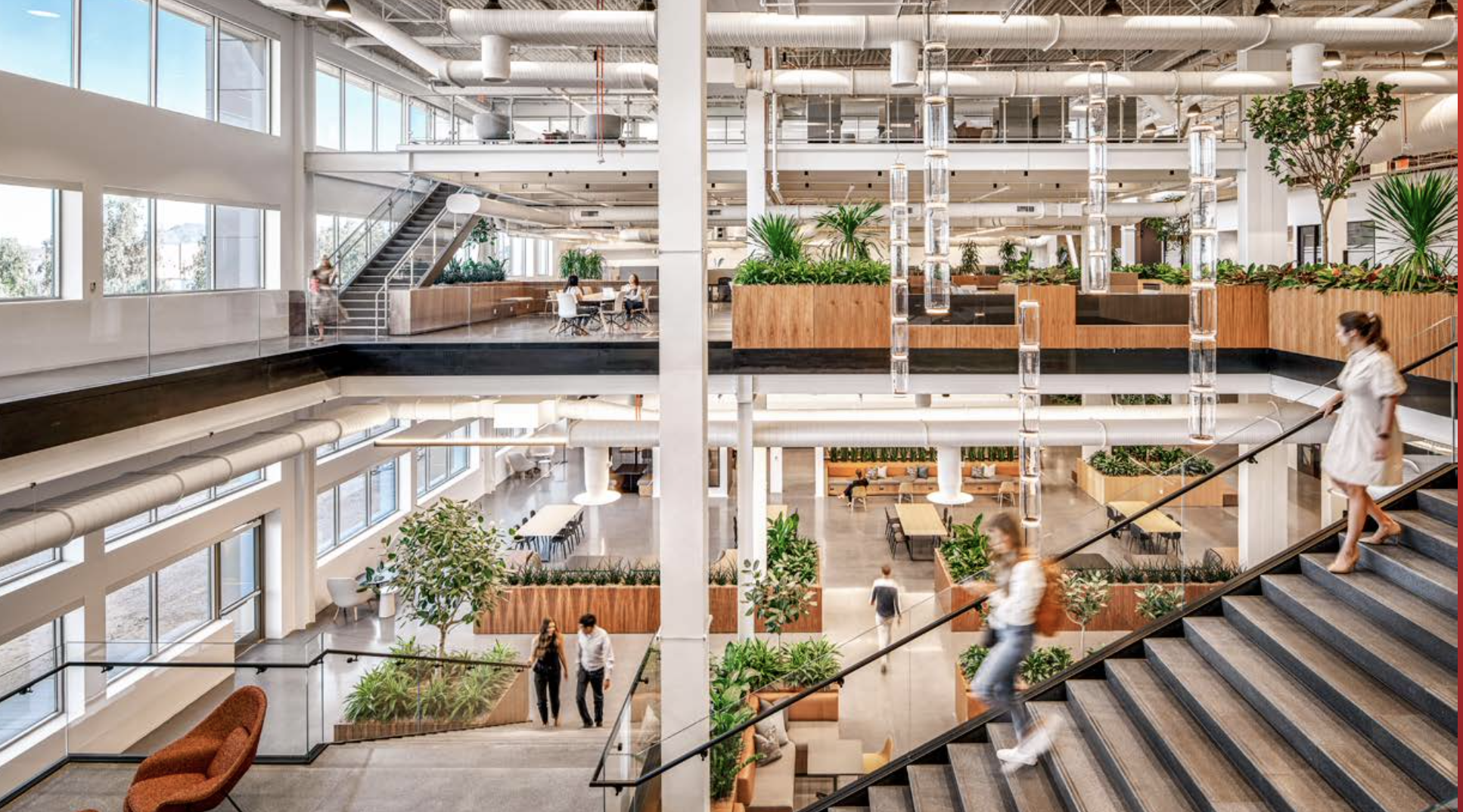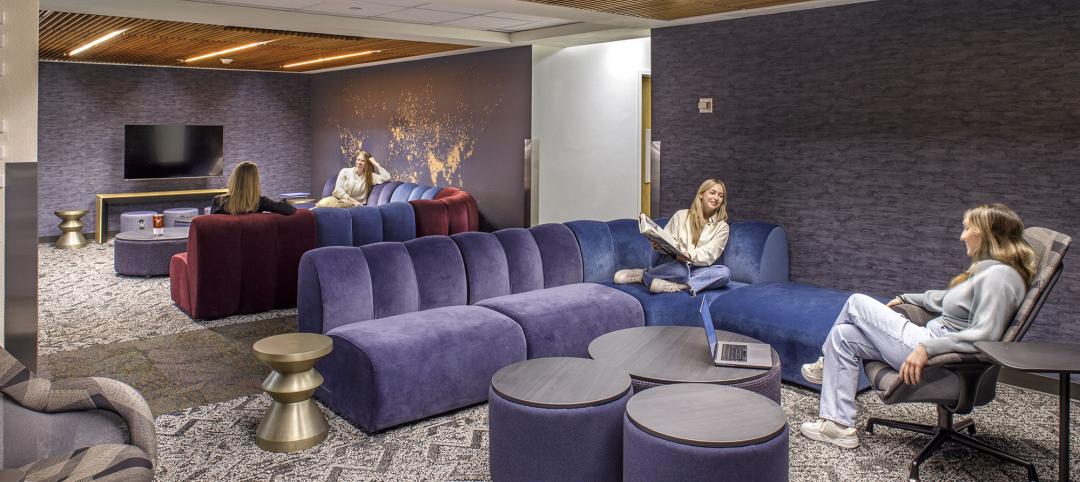Three “Ms”—mobility, multifamily, and multipurpose—will be common and key drivers of design across many practice areas, according to Gensler’s Design Forecast 2023, based on the international firm’s work in more than 80 countries.
The abiding premise of this 189-page report, published by Gensler Research Institute, is that the world is changing radically, and design must respond accordingly with bold new ideas if it’s to impact this transformation of buildings and cities. “Crisis and change have taught us a new way to approach design at Gensler,” write the firm’s co-CEOs Diane Hoskins and Andy Cohen. “It is an ongoing process, where research leads to experimentation and new ideas, which, in turn, lead to further investigations, discoveries, and motivations.”
The forecast identifies 10 megatrends—culled from the firm’s 29 practice areas—that Gensler believes will transform the future of cities:
- Reclaiming experience by prioritizing people’s needs and expectations
- Designs that connect work and life
- Building transformation through redevelopment and adaptive reuse of “stranded” assets to high-value property
- Attainable housing through greater multifamily design
- Decarbonization as part of larger social impact strategies
- Mobility, spurred by electrification, that helps to revitalize communities
- Equitable design that influences master planning to completed buildings
- Intelligent places, driven by technology that redesigns user experiences
- Flight to quality, where Class A space have competitive advantages
- Office as a destination, by featuring a mix of space that facilitate occupant focus and connection.
Rethinking physical spaces

Gensler breaks down its forecast into four quadrants—cities, work, lifestyle, and health—and within each provides more specific insights by market sector and building type. Interspersed throughout the forecast are images of recent Gensler projects that illustrate various points of emphasis.
The forecast’s insights, for the most part, reiterate ideas and strategies that Gensler—and, truth be told, other AEC firms—have been advocating for years: for example, that places need to be designed to encourage engagement and create communities; that mixed-use design and construction are reshaping urban areas more equitably; that digital technology opens buildings to providing more inclusive experiences for their occupants.
What’s changed, and made design more urgent, has been a confluence of societal and economic events instigated by the pandemic and climate change that has altered people’s attitudes and habits about where they work, live, and recreate.
“This is an opportunity to rethink the physical workplace to offer a mix of unique and fulfilling experiences that can attract people,” states Darrel Fullbright, Gensler’s Office Buildings Development Leader, in the forecast’s “Work” section. “The real market differentiator is a new kind of office that allows tenants to sit, stand, and work while moving through sheltered, tempered outdoor space—all while feeling healthier and more connected to their community.”
Giving greater purpose to buildings
Here are some other notable observations in the forecast about the future of design for the built environment:
- Climate action and sustainability are top-of-mind concerns for developers, whose accountability and project transparency are steadily becoming mandatory in more cities. Gensler foresees carbon performance certifications permeating American and global real estate in the immediate future. The world will follow Europe’s lead as it charts a course toward regenerative systems. Transforming existing buildings and materials with reuse strategies will supersede new construction. “Certifications will emerge to better define and quantify socially responsible strategies—the ‘S’ in ESG,” writes Gensler.
- Supporting emotional and mental well-being will become a differentiator for recruiting and retaining talent. Workplaces that provide a sense of health and wellness will have an ecosystem of spaces that provide workers choice. New tools and codified metrics will allow AEC firms and their clients to understand how the built environment affects health and wellness.
- Education is the industry’s second-largest market sector in nonresidential building construction spending. Research shows that students want more choice, more hybrid learning, and generally improved student experiences. In response, institutions are leveraging lessons learned during the coronavirus pandemic while keeping a careful eye on declining enrollment and the global economy. The challenges they continue to face revolve around redefining the purpose of the physical campus, expanding services to support the whole student, and creating environments that prioritize equity.
- In the Residential market sector, the right reuse strategies and tools have started to reimagine underperforming office buildings and retail centers into housing. Trends in “flexible housing—modular buildings and kit-of-parts floor plans—will allow developers to evolve as market needs and expectations shift.
- In one of the hotter growth markets, sports and entertainment, Gensler sees success in terms of moving beyond game day. To thrive as cultural and economic anchors, sports venues must appeal to a broader array of fans than ever before, capturing even non-fans on game days and off days alike. Sports venues are evolving into dynamic hubs that foster social connection and community vibrancy.
- In a consolidating healthcare industry, systems must unlock the promise of scale through mergers and consolidations, the integration of digital technologies, and the harnessing of big data, against a difficult economic backdrop and labor shortages. Community-based approaches that equitably engage all constituents will be essential to delivering exceptional experiences that earn patient-provider loyalty and improve overall population health. Gensler also suggests that healthcare systems will redefine their services to tackle social issues such as affordable housing and food insecurity. AI and machine learning tools will transform healthcare by predicting and responding to patient preferences. Involving patients and providers in the design and implementation of digital solutions will shrink the health equity gap.
- Healthcare also becomes more critical as the world’s population ages. By 2050, 16 percent of that population will be 65 or older. And more people are living to be 100. This trend represents a “huge opportunity” for the senior living industry, states Gensler. The challenge is that rural senior living models aren’t as appealing as they used to be. Older adults are more active and living longer, and they are curious about living in urban centers closer to family and city conveniences. To make that future a reality, “we must design cities to be more affordable and more friendly to older adults,” Gensler states.







Related Stories
Student Housing | May 1, 2024
Pfluger Architects unveils renovated student lounges at all-girls dormitory
In a step toward updating and modernizing on-campus housing to attract a range of students, Texas-based Pfluger Architects renovated the student lounges in Kinsolving Hall, a five-story, all-girls dormitory at The University of Texas at Austin initially built in 1958.
K-12 Schools | Apr 30, 2024
Fully electric Oregon elementary school aims for net-zero carbon and resiliency
The River Grove Elementary School in Oregon was designed for net-zero carbon and resiliency to seismic events, storms, and wildfire. The roughly 82,000-sf school in a Portland suburb will feature a microgrid—a small-scale power grid that operates independently from the area’s electric grid.
AEC Tech | Apr 30, 2024
Lack of organizational readiness is biggest hurdle to artificial intelligence adoption
Managers of companies in the industrial sector, including construction, have bought the hype of artificial intelligence (AI) as a transformative technology, but their organizations are not ready to realize its promise, according to research from IFS, a global cloud enterprise software company. An IFS survey of 1,700 senior decision-makers found that 84% of executives anticipate massive organizational benefits from AI.
Codes and Standards | Apr 30, 2024
Updated document details methods of testing fenestration for exterior walls
The Fenestration and Glazing Industry Alliance (FGIA) updated a document serving a recommended practice for determining test methodology for laboratory and field testing of exterior wall systems. The document pertains to products covered by an AAMA standard such as curtain walls, storefronts, window walls, and sloped glazing. AAMA 501-24, Methods of Test for Exterior Walls was last updated in 2015.
MFPRO+ News | Apr 29, 2024
World’s largest 3D printer could create entire neighborhoods
The University of Maine recently unveiled the world’s largest 3D printer said to be able to create entire neighborhoods. The machine is four times larger than a preceding model that was first tested in 2019. The older model was used to create a 600 sf single-family home made of recyclable wood fiber and bio-resin materials.
K-12 Schools | Apr 29, 2024
Tomorrow's classrooms: Designing schools for the digital age
In a world where technology’s rapid pace has reshaped how we live, work, and communicate, it should be no surprise that it’s also changing the PreK-12 education landscape.
Adaptive Reuse | Apr 29, 2024
6 characteristics of a successful adaptive reuse conversion
In the continuous battle against housing shortages and the surplus of vacant buildings, developers are turning their attention to the viability of adaptive reuse for their properties.
AEC Innovators | Apr 26, 2024
National Institute of Building Sciences announces Building Innovation 2024 schedule
The National Institute of Building Sciences is hosting its annual Building Innovation conference, May 22-24 at the Capital Hilton in Washington, D.C. BI2024 brings together everyone who impacts the built environment: government agencies, contractors, the private sector, architects, scientists, and more.
Mass Timber | Apr 25, 2024
Bjarke Ingels Group designs a mass timber cube structure for the University of Kansas
Bjarke Ingels Group (BIG) and executive architect BNIM have unveiled their design for a new mass timber cube structure called the Makers’ KUbe for the University of Kansas School of Architecture & Design. A six-story, 50,000-sf building for learning and collaboration, the light-filled KUbe will house studio and teaching space, 3D-printing and robotic labs, and a ground-level cafe, all organized around a central core.
Senior Living Design | Apr 24, 2024
Nation's largest Passive House senior living facility completed in Portland, Ore.
Construction of Parkview, a high-rise expansion of a Continuing Care Retirement Community (CCRC) in Portland, Ore., completed recently. The senior living facility is touted as the largest Passive House structure on the West Coast, and the largest Passive House senior living building in the country.

















